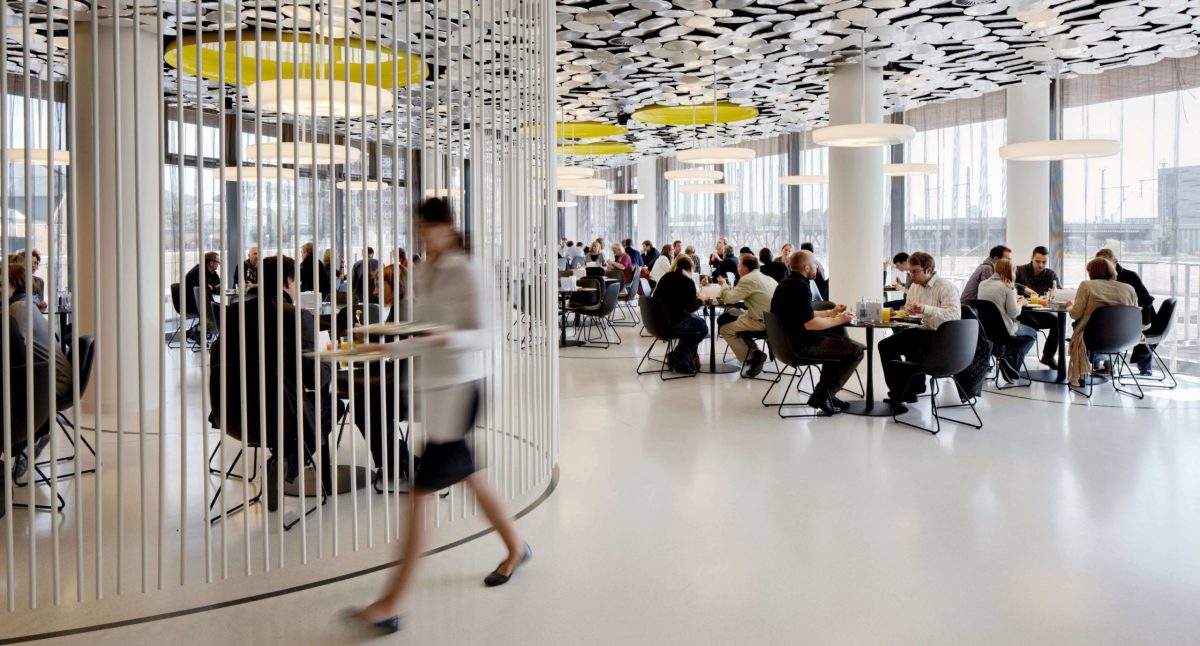Although the following conversation had plenty of dark humor, this is a serious subject. Return to work, return to office or RTW as it seems to be known in real estate, is a complex topic, not least in understanding how you keep the workforce safe and well in their new socially distanced world but also how do you keep them sustained with food and drink.
The challenge is, on its own, difficult and complex but if you then add in some corporate real estate trends you will see it becomes even more acute.
Over the last decade a number of converging trends have led to large populations moving out of Central Business District areas to lower rent out of town complexes. There is natural adjustment required for food when moving from an area with lots of food options to a location with less.

New Work dangers for caterers | Image : https://stock.adobe.com/ Tatiana Atamaniuk
Added to this has been the reduction in overall space allocation per employee. 10 years ago, it averaged 12sqm per person, yet most WeWork facilities are down to less than 6sqm. Desk ratios and building occupancy has gone the other way. From 1 desk per person to 0.75 and from 95 % occupancy to 125 %.
In short, space is squeezed and kitchens and restaurants continue to be in the crosshairs.
What about employee needs? A recent survey in China by OC&C and a similar one in the US from OMNE/RATIONAL showed that previous trends in healthy snacking, vegetarianism and grazing throughout the day are going to accelerate quickly.
Added to this are requirements around increased transparency on hygiene, all understandable considering recent events.
As Hosanna Elarmo, Regional Head of Health, Safety & Wellbeing acknowledged
“the reality is, coming back to work comes with a risk and the goal is to minimize this”
so naturally keeping employees on site to eat but away from large groups is a paradoxical challenge. So how to innovate to achieve these aims?
Janice Castillo, APAC Regional Lead, Workplace Experience for CBRE is going to take the food to the people “We’re accelerating our vertical space activation putting healthy snacks, coffee and light meals in the smaller spaces that people can take time out to eat. These micro-markets were already becoming popular and now we need to go faster”.
There is a similar theme in Hong Kong where Adam So, CEO of SmartRetail a technology led vending company is seeing a similar demand for food options from his mini retail outlets. “We had commenced a trial prior to the crisis on having fresh food available from our machines and now this is becoming a must have solution for many of our clients”
We have already seen some interesting cashless and contactless solutions developed and it seems this is part of the New Work trend for keeping employees not only fed and hydrated but also engaged, productive and safe.
Where does this leave those working from home? In the UK there has been a huge increase in demand for ‘almost-ready-meals’ from the leading supermarkets as the desire for fresh and healthy balances against the need for convenience and value in a work/life muddle that many have found themselves forced to exist in.
How do the catering companies respond? Most estimates are that 30 %-40 % of the workforce will continue to work from home and so even with innovation in taking the food closer to the people within the office there’ll simply be less mouths to feed and that means intense pressure on already thin margins for the catering team.

prepared Lunchbox | Image : Tatiana Atamaniuk, stock.adobe.com
The last mile delivery companies may well have a role to play. John Wright, Senior Vice President of Global Food with global caterer Sodexo explains that with fewer people at work but with almost 70 % seeking familiar lunches idea of Deliveroo and UberEats picking up your lunch from the office and delivering to your home is already a reality in a number of European cities. Even in the office, Sodexo have seen an acceleration in the use of their pre-order, pay and collect technology solutions.
It is difficult to see if the overall volumes will make for a sustainable solution in the medium term.
Many workplaces will be operating a rotating onsite number so you could be in the office three days of the week and at home for two. In Germany a number of caterers who have lost volumes producing meals for schools have pivoted to producing prepared dishes that are then chilled for workers to take home for the days they’re not in the office. As hygiene levels come under the microscope the highly monitored flight kitchens, decimated by the reduced amount of air travel are keeping some capacity by producing pre-portioned “heat to eat” meals for essential workers.
As John says
“We need to continue to use consumer insights to remain agile”
New Work for many and New ways for caterers.
For many caterers, survival is the priority and whilst the large global players cut dividends, furlough teams and hope their geographical and sector diversity will see them through for local caterers this is now a matter of survival. With many of their low paid but essential workers being immigrants who have returned to their homeland this is not a case of just re-starting their business, is about re-building it.
New Work, new way and all of that with a new team.
- The new Standard (understanding consumer attitudes to the workplace expierence (Spring 2020))
- The Foodservice Sector (After COVID-19) A view from China April 2020















